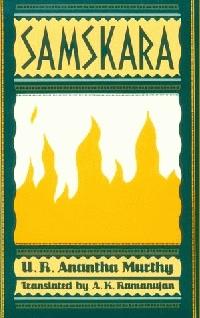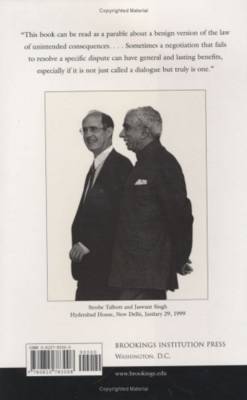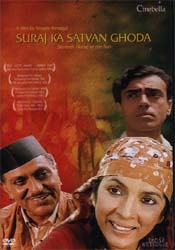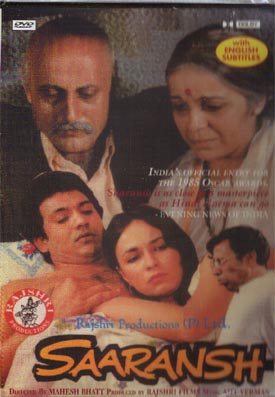Monday, January 24, 2005
I, Rigoberta Menchu: An Indian Woman in Guatemala

My mother was kidnapped. She was raped by the commanding officers. They shaved her head and cut off her ears, cut her bit by bit. Disfigured and starved, my mother started to lose consciousness and was in her death throes. They gave her medical treatment and when she was litle better, they started raping her again and when she was at the point of death again. They took her clothes to the town hall to exhibit that she was in there hands and told everyone that she wanted to see her childrens. It was a ploy to get the other family members.
When they saw that none of her children were coming down to collect my mother's clothes, the army took her to a place near the town where it was very hilly. They put her under a tree and left her there, alive but dying. They didn't let my mother turn over, and her face was so disfigured, cut and infected, she could barely make any movement by herself. They left her there dying for four or five days, enduring the sun, the rain and the night. My mother was covered in worms, because in the mountains there is a fly which gets straight into any wound, and if the wound isn't tended in two days, there are worms where the fly has been. Since all my mother's wounds were open, there were worms in all of them. She was still alive. My mother died in terrible agony.
That was Rigoberto's mother. Gruesome wasn't it?.This is just one death story from many such in the book, "I, Rigoberta Menchu: An Indian Woman in Guatemala". It is set on the backdrop off one of the bloodiest civil war.Rigoberta Menchu Tum is a quiche indian,one of the largest of the 22 ethinic groups of guatemala.She was 22 when she told her story to Elisabeth burgos debray, wife of the Marxist Regis Debray.Debray published her biography in 1983, which catapulted rigoberta into international fame and ultimately to the nobel peace prize in 1992. Making her the youngest Nobel Peace Prize recipient.
Rigoberta potraits the whole story in black and white.Good vs evil.where the mayan indians are totally good and the ladino /military is totally bad.The situation at that time was such that you wont live to see the next day if you talk against the government. People just disappear, heck villages disappear. Lawyers, judges, union leaders and any one who talks against the govt will disappear or will be killed in unfortunate accidents. None of the captured rebels survived, they were tortured in the most excruciating manners. massacers, mass graves ,there was nothing to stop the military. Very few Human rights organization were ready to go to operate in guatemala during that time.The blood thirsty military killed around 200,000 of its own people.This was a story that came out when the military was in midst of an ethinic cleansing.
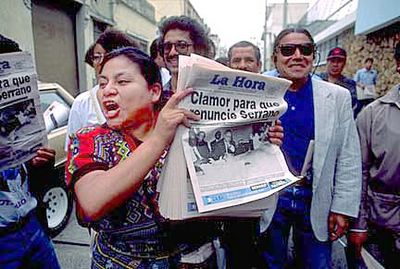
Except for her sisters almost everybody dies in rigoberta's family. Filipie her brother dies in the finca or the coffee/cotton estates they work.
They sprayed the coffee plants with pesticides by plane while we were working , as they usually did, and my brother coudn't stand the fumes and died of intoxication.
Another brother get's kidnapped.Rigoberta's and neighboring villages were commanded to attend a meeting to be held in a nearby town. At the outdoor meeting, many kidnapped indigenous were shown to the crowd in their tortured states - her brother's
head was shaved and slashed. He had no nails. He had no soles to his feet. The earlier wounds were suppurating from infection…" After lecturing the indigenous, the soldiers poured petrol on their prisoners and burnt them all alive.
Rigoberta's father Vincent menchu was an indian leader. They were protesting against the govt in the capital and took refuge inside the spanish embassy thinking that they will be safe inside the embassy. The military burn's down the embassy, burning everyone alive.The spanish ambassador escapes the embassy minutes before the fire.
After all these, rigoberta learns spanish and other mayan languages, becomes a union activist to fight against the oligarchy.This book bought the plight of the indigenous people to the attention of the world. People where outraged, Rigoberta became the international organizor for the resistance movement in guatemala.This book entered the syllabus of lot of american universities.
More than half of the book is about there customs and culture and the rest is the biography of rigoberta menchu. The narration switches back and forth between the poor and simple tribal customs of the indians and rigoberta's life story with the atrocities committed by the military on the indians. It has lot of stories on the atrocities and the torture techniques of the military, which will move anyone who is reading the book.
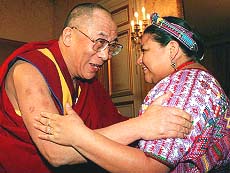
There was another book released in the late 90's called "Rigoberta Menchu and the Story of all Poor Guatemalans" by david stoll which says that Rigoberta menchu has falsified lot of information about her and that Elisabeth debray has painted the whole story in a marxist narration style.Some people even appealed for the Nobel committee to revoke the prize.But the committee was agains't it.
There are lot of pro and con discussion regarding the validity of what rigoberta said.But none the less those kind of atrocities did happen, if not with menchu with some other indian women. And this book brought the international attention to this beautiful country.
more links
http://www.worldtrek.org/odyssey/latinamerica/rigoberta/rigoberta_story.html
http://www.wmich.edu/dialogues/texts/irigobertamenchu.html






